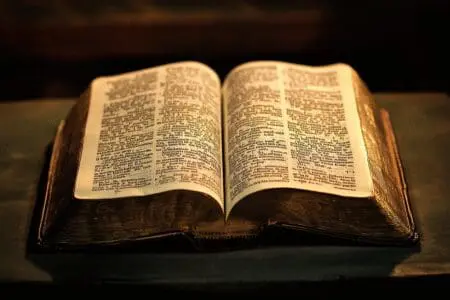Ever walk into a bookstore and get hit with a wall of Bibles? It’s a lot. King James Version. New International Version. The Message. English Standard Version. Catholic Good News Bible. The list goes on and on. It’s enough to make anyone, religious or not, ask a really simple, foundational question: Are all Bibles the same?
It’s a simple question. The answer is not.
The short answer is a definite “no.” But that “no” doesn’t mean there’s some big conspiracy afoot, and it’s certainly not a reason to get confused and give up. The truth is, the differences between Bibles tell an incredible story—a story of history, of language, and of the wild journey these ancient texts took to get into our hands. Getting why they’re different won’t wreck your faith. It just might make you appreciate the book you’re holding even more.
More in Bible Category
How Many Chapters in Each Book of the Bible
What Is the First Word in the Bible
Key Takeaways
- Different Bookshelves: The most obvious difference is the “canon,” which is just the official list of books included. Protestant, Catholic, and Orthodox Bibles have different numbers of books, especially in the Old Testament.
- Different Translation Styles: Translators have a big choice to make: stay “word-for-word” literal or go “thought-for-thought” to capture the meaning. This single choice changes how a Bible reads more than anything else.
- Different Ancient Sources: We don’t have the original, handwritten scrolls. What we have are thousands of ancient copies. Modern translations often get to use older, better manuscripts that were discovered relatively recently.
- The Big Story is the Same: Even with all these differences, the main story of Christianity—who God is, who Jesus is and what he did, and the path to salvation—is the same across every mainstream translation.
Why Did I See a Different Bible at My Friend’s Church?
I’ll never forget my first trip to a Catholic Mass. I grew up Protestant, and our Bible was a known quantity. Genesis to Revelation. 66 books. That was it. So, sitting in that gorgeous, incense-filled church with my college buddy, I was just trying to follow along politely. Then the lector announced a reading from the book of Sirach.
Sirach? I had no idea what that was.
I discreetly flipped to the table of contents in the pew Bible. There it was, tucked in with other names I didn’t recognize, like Tobit and Wisdom. That was the moment. It was the first real-world proof I’d ever seen that the answer to “Are all Bibles the same?” was a loud “nope.” My Bible and this one were physically different. They had different books inside. That simple discovery kicked off a personal quest to figure out why.
So, What’s the Story with the Catholic Bible?
This all boils down to something called the “biblical canon.” That’s the fancy term for the official list of books a faith tradition accepts as scripture. For the New Testament, everyone agrees—the 27 books are the same across all major Christian groups. But the Old Testament? That’s where things get interesting.
Catholic and Eastern Orthodox Bibles have a collection of writings called the Deuterocanonical books, meaning “second canon.” Protestants usually call these same books the Apocrypha. They are ancient Jewish texts written in the time between the Old and New Testaments.
This split happened a long time ago. The Greek translation of the Hebrew scriptures, called the Septuagint, included these books and was super popular in Jesus’s day. Early Christians read them, too. Fast forward to the Protestant Reformation in the 1500s. Reformers like Martin Luther wanted to stick strictly to the books in the official Hebrew Bible canon. So, they moved the Deuterocanonical books into a separate section and, over time, most Protestant Bibles just stopped including them.
Okay, but It’s Not Just a Catholic vs. Protestant Thing, Right?
Not even close. The number of books is just layer one. If you only look at Protestant Bibles, which all share the same 66 books, you still find a dizzying number of different versions. This is where we stop talking about the structure of the Bible and start talking about the words themselves. The reason for all this variety comes down to one thing: translation.
Every single Bible that isn’t in the original Hebrew, Aramaic, and Koine Greek is a translation. And translation is much more of an art than a science. There’s just no single, perfect way to move the meaning of a sentence from one language to another, especially across a 2,000-year gap. The teams who create these Bibles have to make some big calls about what they’re trying to achieve.
Why Does My Grandpa’s Bible Sound So Old-Fashioned?
This question cuts right to the chase. My grandmother reads only her King James Version (KJV). It’s a beautiful old book, the leather cover soft from use. I remember trying to read a Psalm from it when I was a kid and getting totally bogged down in the “thees” and “thous” and “forsooths.” The language was like a locked door.
When I compared it to my own New International Version (NIV), the difference was night and day. My NIV used modern, direct English I could actually understand. But then I saw something else. My Bible had these little footnotes. They’d say things like, “Some early manuscripts do not include this verse.” I realized the Bibles didn’t just sound different; they sometimes had slightly different text. This wasn’t about whole extra books like Sirach. This was about the actual words on the page.
How Can Two Bibles Say Different Things?
It all comes down to two big things: the translator’s philosophy and the ancient manuscripts they use. First, let’s talk philosophy. Any translation team has to decide where they want to live on the spectrum between super-literal and super-readable.
What Does “Word-for-Word” Actually Mean?
This strategy, called formal equivalence, tries to stay as close to the original language’s grammar and word order as possible. Translators look for the single best English word for each Hebrew or Greek word.
- Examples: King James Version (KJV), New American Standard Bible (NASB), English Standard Version (ESV).
- Why it’s great: These Bibles are amazing for deep study. They keep the original flavor and phrasing, so you can see more of how the original text was put together.
- The downside: Being this literal can make for some clunky English. A literal translation of a foreign idiom can sound like nonsense. It would be like translating “it’s raining cats and dogs” word-for-word into Spanish. You’d just get confused looks. The ancient world had its own idioms, and this approach can sometimes make them hard to spot.
Then What is “Thought-for-Thought”?
This philosophy, or dynamic equivalence, focuses on getting the original author’s meaning across, even if it means not sticking to their exact words. Translators ask, “What was the author trying to say here?” and then figure out how to say that same thing in natural, modern English.
- Examples: New International Version (NIV), New Living Translation (NLT), Good News Bible (GNB).
- Why it’s great: They are so much easier to read. These Bibles flow like a normal book, making it easier to grasp the big picture without needing a dictionary.
- The downside: It’s more interpretive. The translators have a bigger role in shaping the text because they’re translating ideas, not just words. This means two different teams could translate a tricky passage in slightly different ways.
Are Paraphrases Really Bibles?
Go all the way to the other end of the spectrum and you find paraphrases. These aren’t really translations. A paraphrase takes the translated text and rewrites it in today’s language to make it as clear and impactful as possible.
- Example: The Message (MSG) by Eugene Peterson.
For years, I could not connect with the Apostle Paul’s writings. In most Bibles, his sentences are long, dense, and full of complex grammar. My brain just shut down. Then a mentor told me to try reading a chapter from Philippians in The Message.
It was like a light switch flipped on. The passion, the logic, the joy—it was all there, in language that my 21st-century brain could grab onto. It didn’t replace my study Bible, but it blew open a door that had been sealed shut. Paraphrases can be an amazing way to see the Bible with fresh eyes.
If the Translations Are Different, What Did the Bible Originally Say?
That’s the big one. This brings us to the second huge factor: the source texts. The whole process of figuring out the original wording of the Bible is a science called textual criticism.
Do We Have the Original Scrolls?
Nope. We don’t have the very first scroll of Isaiah or the original letter Paul wrote to the Romans. They were written on materials that would have turned to dust thousands of years ago. But we have something even better: thousands and thousands of copies from different times and places.
Before the printing press, scribes had to copy every single document by hand. It was a slow, careful, and sacred job. In the last 150 years, incredible discoveries have completely changed the game. The most famous is the Dead Sea Scrolls, which gave us Old Testament manuscripts that were a thousand years older than anything we had before. For the New Testament, we have over 5,800 Greek manuscripts. Some were copied within just a couple of generations of the originals.
Why Do the Copies Have Differences?
Imagine asking ten friends to copy a 300-page book by hand. You’d get ten copies, but none would be perfect. The story would be the same, but you’d find little mistakes—a misspelled word, a skipped line, a note someone added in the margin. It’s the exact same with the biblical manuscripts.
Textual critics are like detectives who study these differences (called “variants”) to piece together what the original most likely said. They can do this with an incredibly high degree of confidence. The vast majority of these variants are no big deal at all. For example:
- Typos: Most variants are just spelling differences or obvious slips of the pen. They don’t change anything.
- Small Changes: Things like swapping a synonym, changing the word order, or writing “Jesus” instead of “he” when it’s obvious who is being talked about. Again, the meaning doesn’t change.
- Real Variants: A tiny fraction of these variants are more significant. These are the ones you see in the footnotes of your Bible. But here’s the key: not one of these changes a single core teaching of the Christian faith.
This science allows modern translators to work from a Greek and Hebrew text that is much closer to the original than what the translators of the King James Bible had access to 400 years ago.
So, Which Bible Should I Actually Use?
This is the question that really matters. The best answer is: it depends on what you’re trying to do. There is no single “best” Bible for everyone, for every situation. And the great news is, you don’t have to pick just one.
What’s Your Goal for Reading Today?
Knowing your purpose is the best way to pick a tool for the job.
- For deep, detailed study: If you want to dig into the original language and see how the sentences are built, grab a “word-for-word” version. The English Standard Version (ESV) and the New American Standard Bible (NASB) are trusted for their precision.
- For daily reading: If you just want to read a chapter or two for encouragement and understanding, a “thought-for-thought” Bible is perfect. The New International Version (NIV) is the most popular in the world because it hits a great balance between accuracy and smooth reading. The New Living Translation (NLT) is even easier to read.
- For a fresh look or for new readers: If you feel like you’re in a reading rut or you’re sharing the Bible with someone for the first time, a paraphrase like The Message (MSG) can make the stories feel brand new.
Why Not Use More Than One?
You don’t have to be married to one translation. One of the best ways to understand a tricky passage is to read it in a few different Bibles. Websites like Bible Gateway or the YouVersion app let you pull up multiple versions side-by-side in seconds.
When you see a verse in both a very literal translation and a very readable one, you get a much fuller, more three-dimensional picture of the meaning. It’s like walking around a sculpture to see it from all sides instead of just staring at a flat photo.
It’s a Journey, Not a Problem
Asking “Are all Bibles the same?” isn’t about finding a problem. It’s about starting a journey. The differences you see aren’t signs that the text is broken; they’re the fingerprints of history, language, and deep thought. They come from which books a tradition holds dear, how translators choose to do their work, and which ancient manuscripts they have access to.
In the end, having so many translations is a gift. It lets us connect with the Bible in different ways—from detailed study to big-picture reading. And through it all, the main story, the life-changing message, shines through with amazing clarity. God’s love, Christ’s sacrifice, and the hope of a new beginning—that story is the same, no matter which version you open today.
Frequently Asked Questions – Are All Bibles the Same?

How should I choose the right Bible for myself?
Choose a Bible that suits your reading goals. For daily reading, a thought-for-thought translation like the NIV or NLT may be best. For deep study, a word-for-word translation like the NASB is suitable. You can also consider using multiple translations to gain a broader understanding.
Why do Catholic Bibles have more books than Protestant Bibles?
Catholic Bibles include seven additional books called the Deuterocanonical books, which were part of the Greek Septuagint version of the Old Testament. Protestant Bibles are based on the Hebrew canon, which does not include these extra books.
How do translation philosophies affect the way Bibles read?
Word-for-word translations are more literal and preserve the original language structure but can be harder to read, while thought-for-thought translations are easier to understand but may include more interpretive decisions by the translators.
What causes differences between various Bible translations?
Differences in translations are mainly due to the translation philosophies used. Some Bibles aim to translate word-for-word, maintaining original phrasing, while others focus on conveying the thought or meaning, resulting in more modern and easy-to-read versions.




